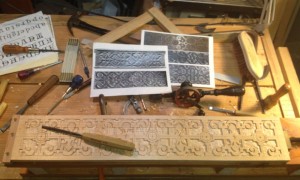New carving project – Travelling Hexagon toolbox
It’s been a rough few months in terms of getting any woodworking in. My work is going like gang-busters right now, and I’ve got a lot going on inside my head (my job is pretty mentally intensive) which is exhausting at times.
This new project is going to be part carving pattern practice and demonstration, and part functional tool box for carrying tools out of my garage. Â I’m going for one of those six sided tool boxes seen in the Toolboxes book by Jim Tolpin. Â I’ve been fascinated by that for a while, and while it might not be “strictly necessary” because I have a nice carved tool tote… I just kind of want one. Â And I wanted some more carving, so there ya go.
Starting with some Alder wood that I picked up previously from Coyote I dressed the edges and face till it was reasonably flat and true.  Since I’m going to carve it I don’t really need to make it mirror smooth, but the Alder does plane up nicely with my fore plane.  Taking the concept of the “design at the point of the tool” I placed my crosscut saw down, padded it by a little bit, and called that the length after accounting for the wood panels at the end.  I don’t really need to measure it out since I know it will be big enough for my longest travelling tool.  I won’t be able to put my longer rip saw in it, but it’s not something I usually travel with and would make it far too long and cumbersome.
Since this will be a six sided box I’m going to do a different carving design on each side as part practice and part demonstration of period styles. Â To layout the pattern I struck a line with my awl down the middle and length. Â Then I used my dividers to pace out some divisions. Â This part is a bit subjective but as long as I base the layout from the center it tends to work out just fine. Â This design uses a square as it’s base unit so I started with a division based on roughly a half inch from the top and bottom, and then paced that out along the length. Â The first few times it was too short or too long, but I kept tweaking it until I had a nice balance between how much border it left at the top/bottom edges, and how far in from the ends it was. Â Again, no idea what measurement this is, and I don’t need to. Â I pricked the length down the board, and scratched in the horizontal layout lines with my awl and square.
You can see the starting point for one of the distinguishing features of “strapwork” with the curls. Â I was not copying a specific pattern here, but rather using a few print outs of designs from existing period boxes and chests I have in my archives. Â The I use my chisels as layout tools to set in the designs. Â This time I didn’t sketch anything out in advance as I have done in past designs, and in some ways it worked out but it was a struggle at times to work things out. Â I think I was mostly successful though, and with more practice it would be almost effortless. Â I tried it this way because I have a theory about the period craftsman I wanted to validate. Â I think they didn’t have templates and the like, they just started with layout lines and a pattern they learned from their Master or the shop, and just adjusted it to fit their stock.
I kept going along this way, figuring out the design on one of sections and then going down the line setting it in. Â Once I figured out the chisels that would make the pattern I wanted I would hold the tool in the same position and walk backwards down the board striking it in sequence. Â I picked this up from Peter’s video on S Scroll carving, and was very helpful for this longer pattern.
After that it’s time to grab my small flattish gouge and start relieving background. Â Here is where I discovered a flaw in my design. Â The little curls have a circular section in the middle that liked to pop out constantly. Â I’ve had to re-glue in almost every one as it would come flying out as I tried to carve away the background around it. Â Something in the way I struck the line, and the relative lightness of the wood.
I’ll be finishing this up and starting on the second panel in a bit, hopefully this weekend.
Badger





[…] Part  1 […]